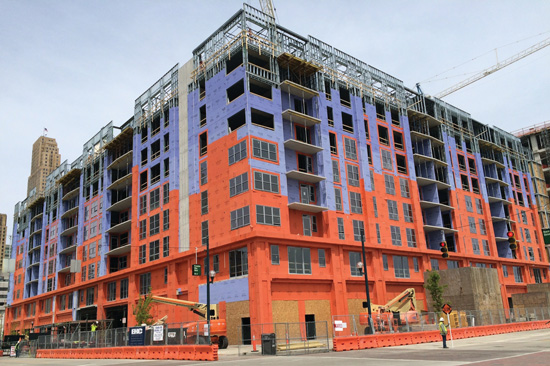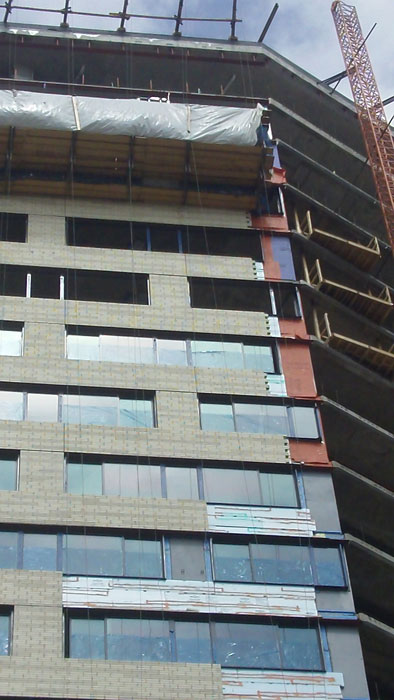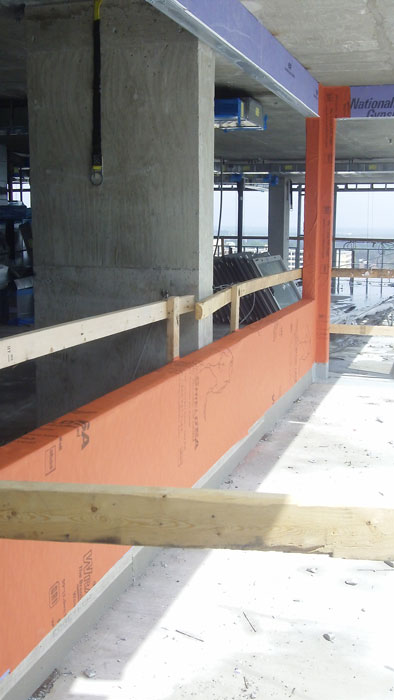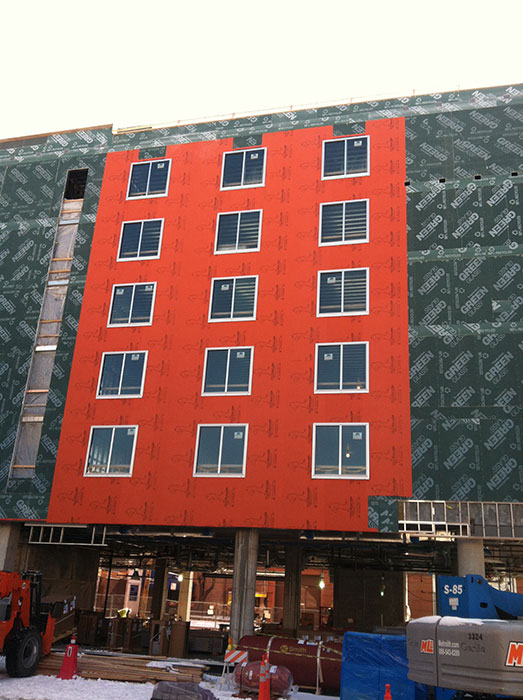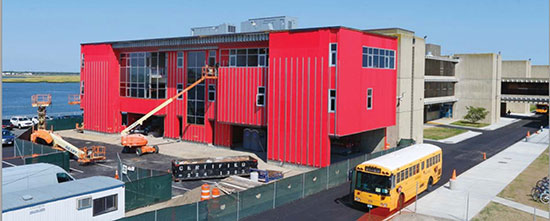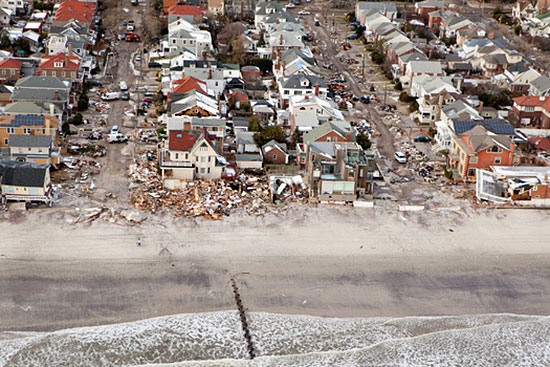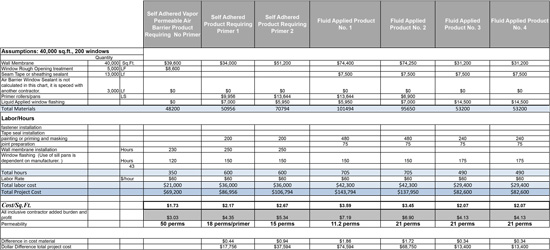Breaking Old Rules for Air-Barrier Installation
Innovative, self-adhered, water-resistive, vapor-permeable, air-barrier sheet membrane that increases performance of the building envelope, lowers costs, and speeds up installation
![]() Continuing Education
Continuing Education
Use the following learning objectives to focus your study while reading this month’s Continuing Education article.
Learning Objectives - After reading this article, you will be able to:
- Explain the natural movement of air, heat, and vapor into and out of a building and how that relates to energy savings, occupant health, and durability.
- Discuss the history of building paper and weather-resistive barriers (WRBs).
- Identify the performance and testing characteristics of breathable, self-adhering WRBs and air barriers that contribute to a durable and energy-saving building.
- Describe the different types of air-barrier technology for a durable building envelope.
- Examine several case studies where an innovative vapor-barrier system sped up construction, lowered costs, increased building envelope quality, and/or contributed to green building certification.
In the beginning, humans were hot or cold, wet or dry, comfortable or miserable, all depending on the weather. As we evolved, comfort became a priority, and then energy savings, and eventually health and durability, and sustainability rose up in our collective concerns. Building paper and weather-resistive barriers (WRBs) have emerged and then evolved to meet our new needs and expectations. Today, the architect or specifier can choose from an astonishing array of weather-resistive/air barriers with various capacities and installation strategies, from those that are tacked, fastened on, glued on, sprayed on, and, ultimately, those membranes that self-adhere.
To clarify the difference between weather-resistive/air-barrier choices, this article is about self-adhered, vapor-permeable WRBs/air barriers, and the role they can play in design and construction of superior buildings that satisfy owners, serve the needs of occupants, and help shield the architect/owners and general contractors from risk. We start with the basics of heat and energy flow, then review the history of air barriers, discuss the basics of self-adhered products and their installation benefits, and finally look at some case studies where a self-adhered WRB/air barrier was used to further the goals of designing and creating a superior building.
Let’s begin with a review of basic building science.
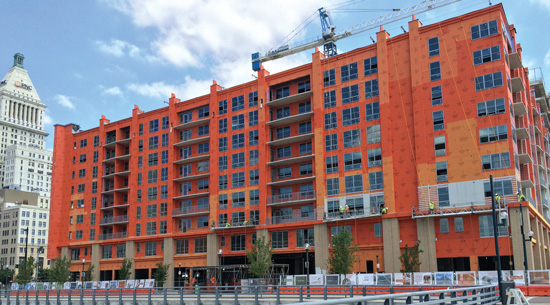
Photo courtesy of VaproShield
As buildings and what we demand of them have evolved, so has the technology for providing air, vapor, and water controls for the building envelope. The most sophisticated system using a self-adhered membrane is not only highly effective, but also simple to apply with a minimum of surface preparation, and can be applied during cold or rainy conditions. Such systems are a win for the designer, builder, and owner.
Building Science: The Movement of Air, Heat, and Vapor
In the design and construction of buildings, it’s important to understand how air, heat, and vapor move into and out of tight structures. The way air, heat, vapor, and liquid water move in and out of a building is best defined by the second law of thermodynamics. This is the study of heat and energy and how they “move” or transfer.
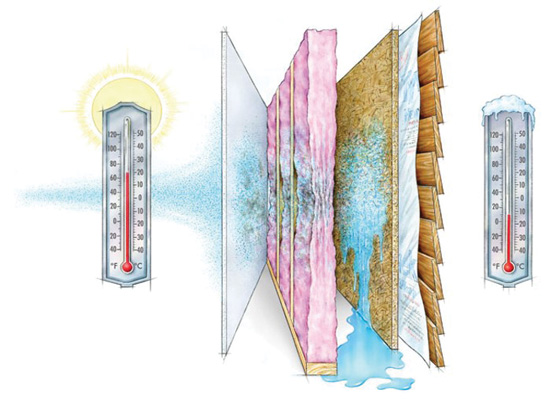
Image courtesy of Green Building Advisor Scott Gibson (Aug. 17, 2010)
When the designer and contractor understand how air, heat, and vapor move into and out of buildings, there is a better chance that the structure will be durable, healthy, and energy efficient.
Air, heat, vapor, and liquid water—driven by the immutable laws of nature—move from more to less when given a chance. That means that higher concentrations move to lower concentrations. Hot moves to cold. Wet moves to dry. Higher pressure moves to lower pressure.
This is easily understood during a northern winter. The cold air outside seems to “want” to come inside, but it’s really the warmth that wants to leave the house. Left uncontrolled, this will occur until the temperature is the same inside and outside.
Insulation and air barriers keep the warm air from escaping in heating climates, predominantly northern states, and keeps the hot air outside in cooling climates, mostly in southern states.
Air BarrierFor insulation to be effective, we need an air barrier to control convective heat transfer. An air barrier is required whether the insulation performs that function or not. This will ensure that connections between the insulation materials as well as penetrations (windows, doors) and transitions from wall-to-wall, wall-to-roof, and wall-to-foundation are properly sealed.
This calls for an air barrier to be installed in the building envelope. When the air pressure is not equal inside and outside (stack effect, wind, or mechanically induced pressure difference), and there is no identified air barrier, the air will move from high to low.
Vapor ControlsThis brings us to the issue of vapor, or water in a gas form. We feel most comfortable when the interior relative humidity ranges from 40 percent to 60 percent. In a hot and humid climate, it needs to be below 50 percent to manage some indoor air-quality issues. However, in the summer in the South, the outside relative humidity is often more than 90 percent.
We use the air-conditioning to lower the temperature and the relative amount of moisture in the air in the form of vapor. The vapor movement from higher to lower concentrations through building materials is typically minor, as well as slow to necessitate additional vapor control over the natural vapor control of the materials used in wall construction.
It is primarily the air-transported moisture that moves through the building’s envelope that is a problem.
When surfaces reach dew point, the vapor in the air or from vapor diffusion condenses, changing into liquid water. If this water is trapped in a wall, floor, or roof cavity and is not allowed to dry, it can, over time, cause problems. It not only degrades the building materials that are food sources for fungus, it also causes oxidations that will rust metal studs and other metallic wall components.
Ideally, a building envelope membrane is resistant to liquid water and air, but allows vapor to enter and exit, within certain bounds. Vapor movement is the rate at which water vapor can diffuse through a material, known as its water vapor transmission rate (WVTR) or water vapor permeance.
The permeance is measured in perms, where one perm is one grain of water per hour through 1 square foot of material, induced by a vapor pressure difference of 1 inch of mercury across the two surfaces of the material. Its driving force is a difference in vapor pressure, and its movement is always high to low. A high vapor pressure means that the number of water vapor molecules in the air is high. Vapor diffusion is different than air transport or convective vapor transport. And it is typically very slow.
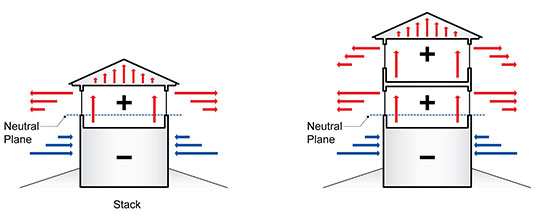
Image courtesy of VaproShield
The stack effect brings in outside moisture and pollutants and adds to the work of the HVAC system.
In heating climates—areas where there is a significant need for heating—you may have noticed how the upstairs is often warmer than the down stairs if the ventilation is not balanced. Or it is warmer at the ceiling than at the floor. As the warm air rises, it creates a positive pressure at the top of the building and a negative pressure below. These pressure differences force warm air out through the top of the building, sucking cooler air into the lower section of the building. This is called the stack effect.
The stack effect and air leakage adds to the amount of air the HVAC system needs to cool or heat, and will also bring in outside pollutants and moisture.
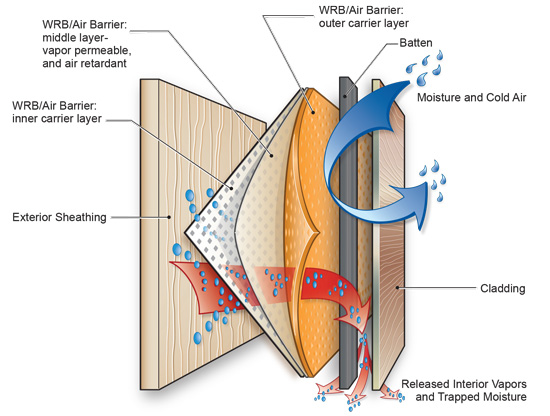
Image courtesy of VaproShield
The key to an efficient, healthy, and durable building is to control airflow, which brings in vapor, and stop heat flow.
To be most effective, the thermal (insulation) barrier, air barrier, and moisture barrier (liquid and vapor water) should be continuous all around the building exterior, including all rough openings, such as windows. The key, says building science consultant Scott Wood, “is to control air flow (which brings in the vapor), and stop convective heat flow.”
Stopping airflow and liquid water from entering a building envelope, yet allowing vapor to come and go, are the sophisticated functions we ask of our modern building envelopes. Let’s see how we got here.
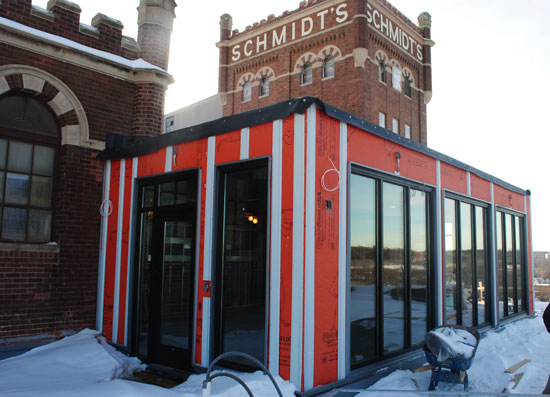
Photo courtesy of VaproShield
When a brewery was founded in St. Paul, Minnesota, in the mid 1800s, little thought was given to air or vapor intrusion. Buildings were drafty, and energy was cheap. But when the brewery was converted to artists’ lofts in 2013, the buildings were brought up to today’s standards with a technologically advanced self-adhered WRB/air barrier.
History of Building Paper and Weather-Resistive Barriers (WRB) and Air Barriers
While the art and science of elegant, affordable, manageable control of air and heat in buildings is now commonplace and required by codes and standards, it wasn’t always like that.
Homes in the early part of the 1900s were drafty with lap siding and empty stud bays, and were alternately cold or hot, dry or humid, depending on the season and location. The status quo worked for several reasons. We had not yet invented air-conditioning, so we didn’t know that sleeping on the porch in summer was not the only option. We were accustomed to feeling the impact of seasons and weather, even inside the house. The leakiness of the house let heated air escape in winter, which was uncomfortable and costly, but it also ventilated the house, which provided benefits in drying the walls and cleaner indoor air, depending of course on the quality of the outdoor air that was entering.
In time, builders tacked simple kraft paper onto the studs before adding the cladding to stop liquid water entry into the building. The paper could get wet and then dry out, which lessened the chance of mold and rot. Over time, though, season after season, the paper tended to degrade, and that’s when pine tar was added to make the paper more resistant to moisture.
Insulation was not a big issue in the early part of the 1900s. Homes were generally heated with wood or coal-fired furnaces and steam heat, and in cold northern winters, you simply added more wood or coal if you were cold, or opened the windows if you were hot.
The use of tarpaper, saturated by now with a petroleum-based product, was a very popular way to build back in the middle of the last century. However, it was difficult to use in cold weather. The corners could break. Eventually, the product was improved to make it a little more durable. And the main goal was to control water, which it did.
The invention of air-conditioning raised expectations of occupant comfort. Once we experienced the comfort of a cool home during a hot summer, there was no going back.
In the mid-1970s, the oil embargo and energy crisis changed forever how we build, insulate, and ventilate homes. However, the correct changes didn’t come right away, and there were many building and material failures as building scientists, building material manufacturers, builders themselves, and code and standards figured out how to “build tight, ventilate right,” as we often hear today.
Once energy became more expensive, insulation got thicker, and trapped vapor became a major, expensive, and destructive issue.
In the 1970s, modern house wraps came on the market and revolutionized air and moisture barriers. But some problems emerged. The material can rip and tear, both from improper installation using staples and from the forces of wind. Once the integrity of an air barrier is compromised, its value as a protective factor diminishes.
Peel-and-stick membranes with a primer application eventually came on the market. Without the staples and potential tearing that can impact tacked-on barriers, these promised a more thorough attachment. Again, some problems emerged. Typically, primers are needed on sheathing. These often contain VOCs, which the green building movement and health and environmental concerns have made unpopular. Most egregious, primers diminish the perm rating. Joint and corner treatment is often needed, and the installation is time sensitive and weather sensitive.
Fluid-applied air barriers have gotten quite a bit of attention in the design and build industry. Videos showing a smooth and consistent fluid application are compelling. However, there are some issues and drawbacks with this type of product. Rain will wash off the material if not fully cured. Low temperatures restrict curing. Transition membranes need to be included to span gaps as well as lengthy prep time for the substrate. And because it’s a chemical liquid that could potentially harm installer and bystanders, personal protective equipment is needed. Methods must be put into place to contain spills and overspray. Surface preparation can be arduous, with the need to fill holes and gaps before application. And there is a potential for the product to become contaminated with common construction debris and dust.

Illustration courtesy of VaproShield
Self-adhered, water-resistant, vapor-permeable air-barrier sheet membranes that do not require primer are applied directly to the sheathing in a wide variety of weather conditions.
Finally, we come to self-adhered, water-resistant, vapor-permeable air-barrier sheet membranes, which combine the performance necessary to reduce risk and create superior buildings with the ease of installation that lessens the chance it will suffer from installer error, or hold up a job due to weather or sequencing. We’ll talk more about these products in the following sections.
Performance and Testing of Breathable, Self-Adhearing WRB/Air Barriers
In the design and build industry, this new class of breathable, self-adhering weather-resistant barriers/air barriers is getting attention. Such a product, with extra UV protection for use in open joint applications, was recognized as a 2014 Record Product by Architectural Record, one of only 15 winners in the Facades category. In announcing the award, the judges listed the product’s attributes as: a black, UV-stable, water-resistive, vapor-permeable air-barrier membrane for open-joint rainscreen cladding, the zero-VOC membrane installs in a single layer in temperatures as low as 20 degrees Fahrenheit. The Class A fire-rated material has a Flame Spread Index of 0, and is highly vapor permeable, reducing incidence of mold, mildew, and rot.
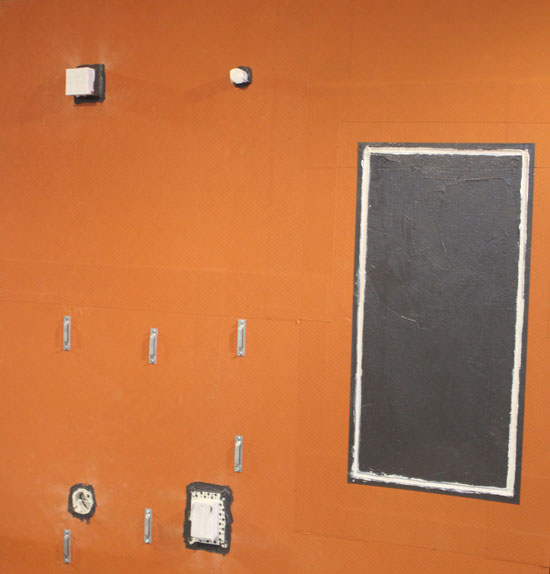
Photo courtesy of VaproShield
An assembled system is tested according to criteria set forth by the performance guidelines of an assembled system.
The guaranteed efficacy of these products depends on reliable testing methods. The ASTM E2357: Standard Test Method for Determining Air Leakage of Air Barrier Assemblies measures the performance of an assembled system rather than the amount of air leakage through a single component. The installed assembly is tested under a multitude of negative and positive air pressures, including extreme wind gust load conditions.
The ASTM E2357 test method measures and compares the air leakage through an opaque, non-penetrated wall assembly against the air leakage through a wall assembly with pipe penetrations, brick ties, electrical boxes, foundation transitions, and lap seams and flashings. The walls are subjected to extreme positive and negative wind-load conditions and the measured air leakage recorded. If the measured air leakage rate passing through the wall with penetrations is greater than 10 percent of the opaque wall, the assembly fails. A passing grade for this test indicates the quality of the system to ensure the installation as provided will be airtight.
ASTM E2357 Differs From Previous Test StandardsIt’s important to note that while codes regulate air-leakage rates or limits, test methods verify the performance characteristics. The more common requirement for acceptable air leakage rate for a membrane is set at 0.004 cfm/ft2 at 1.57 psi of air pressure (0.02 L/s m2 @ 75 Pa). One such test method used is ASTM E2178: Standard Test Method for Air Permeance of Building Materials. In addition to flexibility, tensile strength, and a few other durability tests, it measures the air permeance of individual materials, but only to 1.57 psi (75 Pa) of air pressure. With the introduction of ASTM E2357, it is realized most building projects experience significantly higher wind loads, both negative and positive than 1.57 psi (75 Pa). ASTM E2357 verifies the air-barrier system approach will stand up to the extreme weather conditions a building enclosure may experience during its lifetime. The ASTM E2357 test is also a far more realistic test because it includes multiple penetrations like a real building. The ASTM E2178 test is simply for materials, which is unrealistic because buildings always have penetrations.
At least one company uses the ASTM E398 test to evaluate vapor permeance of the membranes. This testing technology, invented more than 20 years ago for use by the packaging and medical industries, allows for faster, more precise measurements than the traditional ASTM E96 testing methods, while still allowing for comparison with ASTM E96 WVT (Water Vapor Transmission) values.
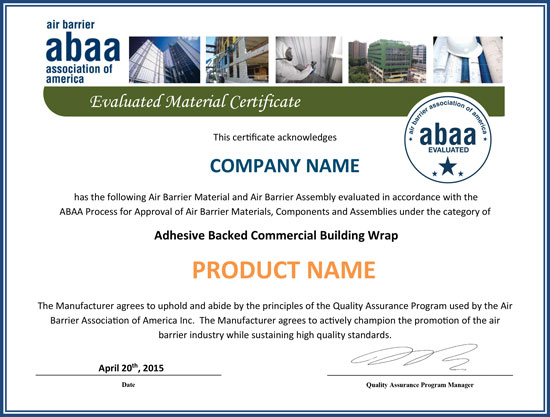
Image courtesy of VaproShield
In response to the latest technologies, the Air Barrier Association of America created a new category for certification titled Adhesive Backed Commercial Building Wrap.
Approval by Air Barrier Association of America
The Air Barrier Association of America (ABAA) is the premier organization that verifies and approves the effectiveness of air barriers. Products should have this approval for optimum results in the building enclosure. In April of 2015, ABAA approved membranes are fully self-adhered, water-resistive barriers and air barriers with a cutting-edge adhesive that does not require primers, is void of VOCs, and can be applied in below freezing temperatures. The reason this is remarkable is that an ABAA category for such innovative products did not previously exist, and thus a new category was created for Adhesive Backed Commercial Building Wrap. This presents further evidence that the design and manufacture of air barriers continues to evolve.
Questions to Ask when Specifying an Envelope Membrane System
To determine the best membrane for the building envelope, the architect, designer, or specifier should ask these questions:
When choosing between self-adhered WRB/air barrier, peel-and-stick with primer, and fluid-applied barriers, what are the installed costs and total time in labor to complete the task? When costing out a wall assembly, considering just the cost of the materials and not the labor cost for installation results in an inaccurate estimate. To accurately estimate the cost of the assembly, both the material and the labor should be considered. This should include the time needed to prep the sheathing to receive the barrier. Here is an example:
Is extensive field training necessary to install the product? Increasingly, as skilled labor shortages affect the industry, installation errors tend to increase. Specifying a complicated, difficult-to-install product could lead to installation errors and increase failures, and thus risk. Ideally, the product should require minimal contractor field training.
How is the product affected by the weather? Unless the project is in San Diego, California, or in a mild Mediterranean climate, there will be weather. That means, for most of the country, times of rain and freezing weather. If the WRB/air barrier cannot be installed in freezing temperatures, the project could well shut down until the weather improves. The cost of a shutdown could be exorbitant and will certainly be disruptive to the remainder of the construction schedule. Ideally, the product can be installed in freezing temperatures.
Is the membrane UV stable? This question should be asked for several reasons. It should be a concern if there is a possibility of construction delays. If there are, and the membrane is exposed for an extended time before the cladding installation, the membrane will be at risk of degradation from UV damage. It’s important to note how long the membrane can be exposed. Also, if there are exposed gaps in the sheathing, the membrane behind it should have superior UV performance.
What is the perm or drying rate? The most effective vapor-permeable, self-adhering air-barrier membrane will have the highest drying capacity. As the permeance increases, so does the drying capacity.
In terms of sequencing, when can WRB/air barriers be installed? Can the WRB/air barriers be installed before or after the roof? When walls are dry? The flexibility of the material to fit into the building schedule could have massive impact on the job.
What is the compatibility with other materials? This is the emerging issue with new products that come on the market. While the material itself might perform well, it needs to be compatible with the substrate and cladding. Check to see if the barrier is compatible with the most common substrates:
• Exterior gypsum
• Rigid insulation
• Precast concrete
• Concrete block
• Cast-in-place concrete
• Plywood
• Pre-painted steel
• Galvanized metal
• Aluminum (painted, mill)
• Anodized aluminum
• Rigid vinyl
The exterior cladding must also be considered. Many buildings use multiple types of cladding to create a certain architectural visual appeal, so for ease of installation and construction schedule, a single WRB/air barrier should perform behind multiple types of cladding.
Wall PreparationFor proper installation of the self-adhered WRB/air-barrier membrane, all surfaces must be dry, sound, clean, and free of oil, grease, dirt, excess mortar, or other contaminants detrimental to the adhesion of the water-resistive air-barrier membrane and flashings. Trades workers should fill voids and gaps in substrate greater than 7/8 inch in width to provide an even surface.
Plus, a self-adhered WRB/air barrier (it’s not actually required, but highly desirable because the drainage plane allows the water somewhere to leave the structure) requires a ventilated, unimpeded vertical drainage cavity or rainscreen system to be incorporated into all WRB/air-barrier installations. It’s likely the membrane manufacturer offers compatible and corresponding accessories to accomplish this, as well as flashing materials for window and door rough openings, and flashing materials for transitions.
LimitationsWhile most self-adhered, water-resistive, vapor-permeable air-barrier sheet membrane are quite durable, there are some general and practical limitations. Many carry recommendations to be installed in temperatures no lower than 20 degrees Fahrenheit. Contamination of the wall and building site will adversely affect the membrane’s water resistance. Many of these membranes should not be subjected to asphaltic materials, chemicals, surfactants, or cleaning compounds that could affect the water resistance of the membrane surface; if exposed, replace affected membrane.
Green Building Attributes
There are several factors that make a self-adhered, water-resistive, vapor-permeable air-barrier sheet membrane beneficial to an architect’s sustainable building goals. If one is trying to meet the criteria of the Living Building Challenge, look for a membrane that is void of all indicated red-list chemicals.
A membrane might be desired that is highly UV resistant, which means it can remain fully exposed for up to 180 days prior to installation of cladding system. With an open-joint cladding system, the membrane must be UV resistant.
Also, self-adhered, water-resistive, vapor-permeable air-barrier sheet membrane protects against water intrusion, but allows building materials that may have become wet during the construction phase to dry out, reducing the risk of wood rot, deterioration, or corrosion.
In the USGBC’s LEED green building certification program, a self-adhered WRB/air-barrier membrane can contribute to credits that address low-emitting materials such as adhesives and sealants.
At the National Renewable Energy Lab in Golden, Colorado, the only national laboratory solely dedicated to advancing renewable energy and energy-efficiency technology, a self-adhered, water-resistive, vapor-permeable air-barrier sheet membrane was chosen to protect the building envelope. The lab achieved LEED Platinum status.
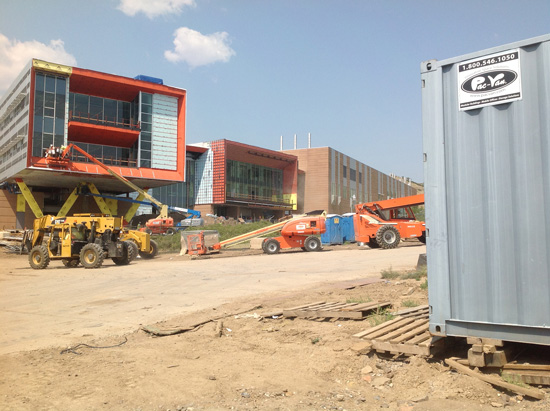
Photo courtesy of VaproShield
The self-adhered, vapor-permeable air-barrier membrane contributed the building’s overall energy efficiency by being part of the continuous air-barrier system.
Conclusion
There is an art and science to designing and constructing buildings that are beautiful, comfortable, healthy, resource efficient, and durable. An effective building envelope is critical to a building that will last and reduce the architect’s risk. The weather-resistive air barrier should stop air and resist water. In addition, the installation should be compatible with today’s level of skilled labor, or lack of it, and embody qualities that allow it to be installed in freezing weather and without deployment of extensive equipment and void of pollutants. When determining the right WRB/air barrier for the building, the architect should consult with experts and be sure to ask all the right questions. If one is designing a beautiful and/or functional building, specifying a superior building envelope could give that building added longevity, and increase the architect’s reputation and standing.

|
VaproShield |

